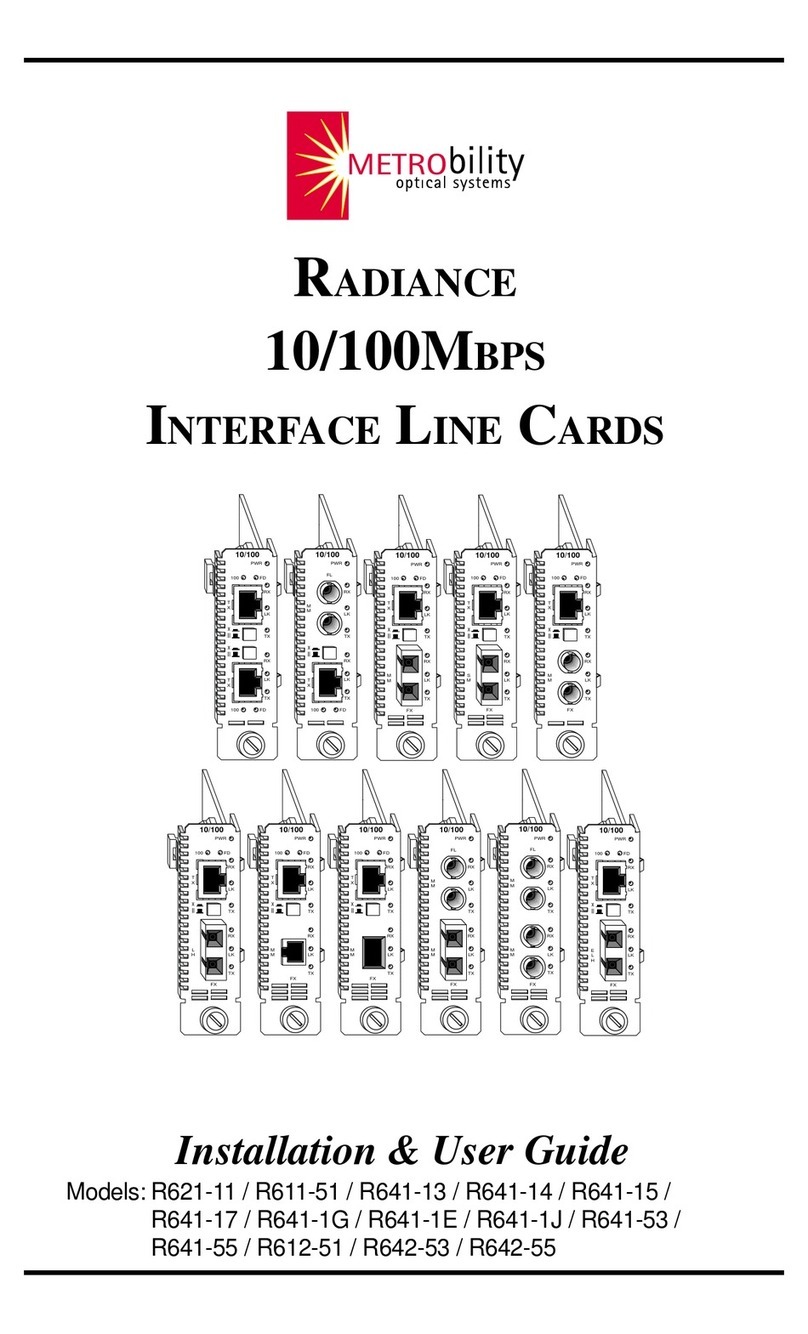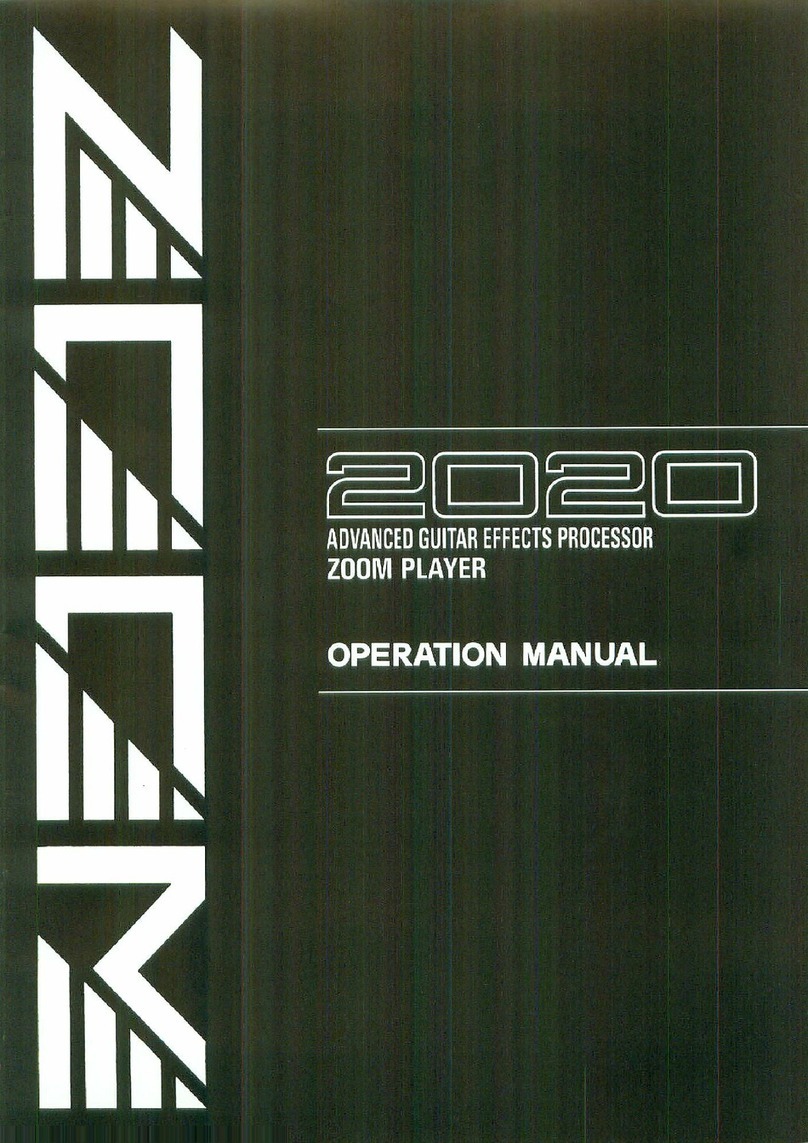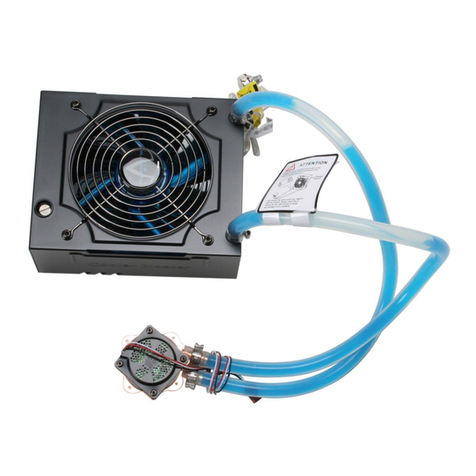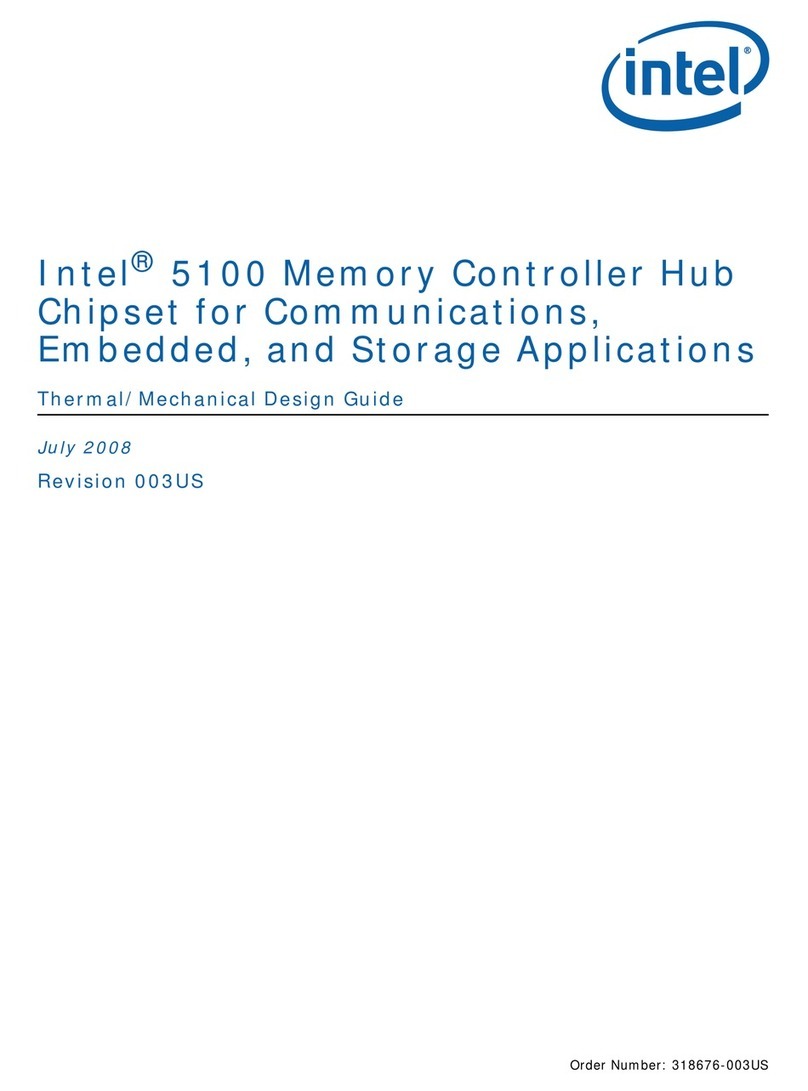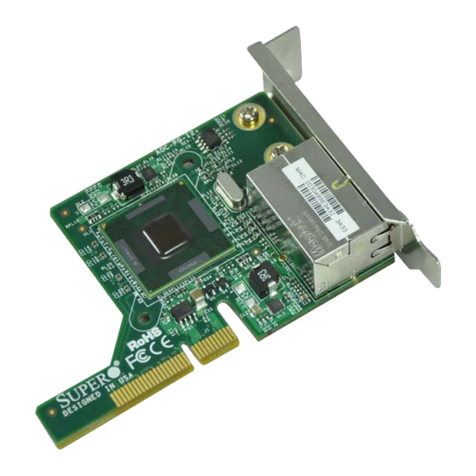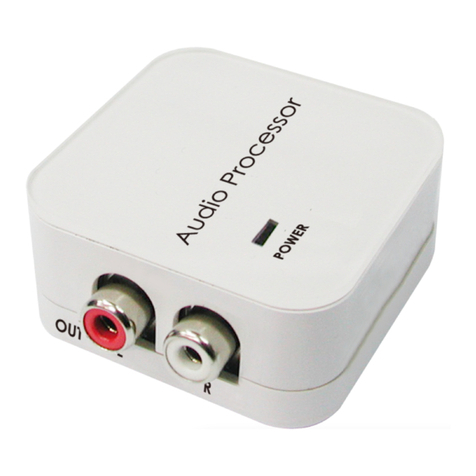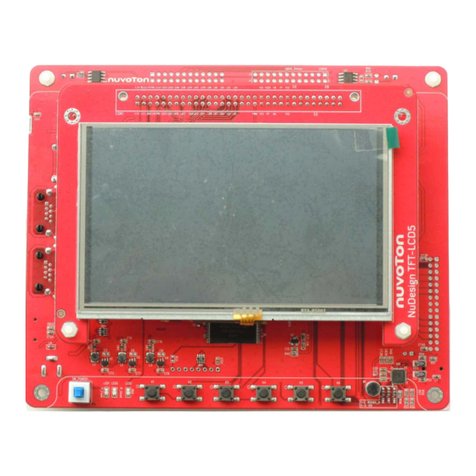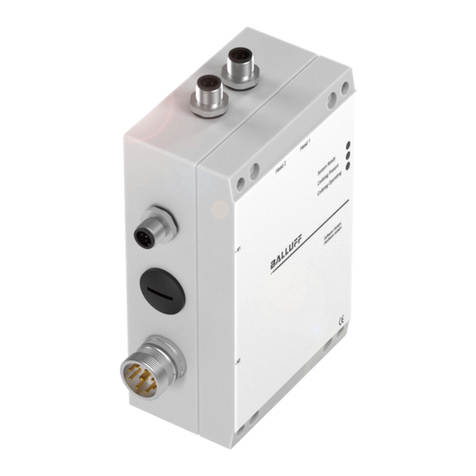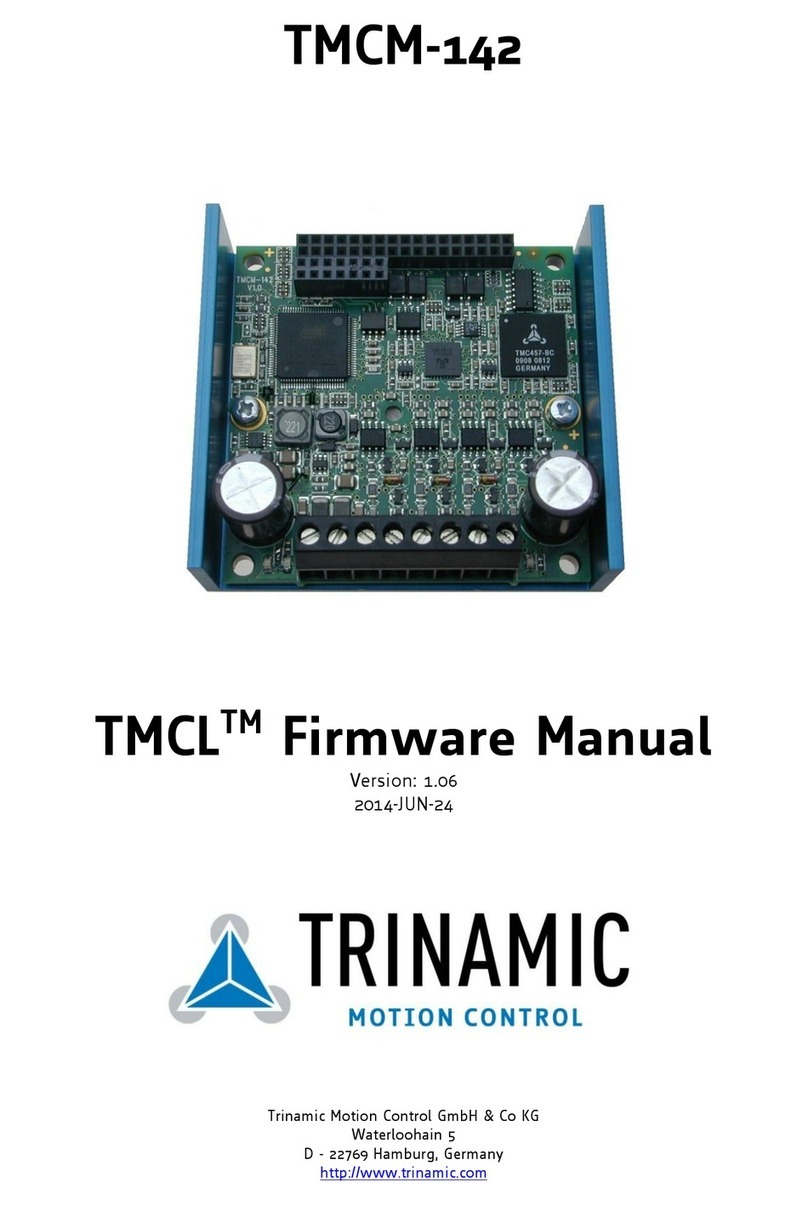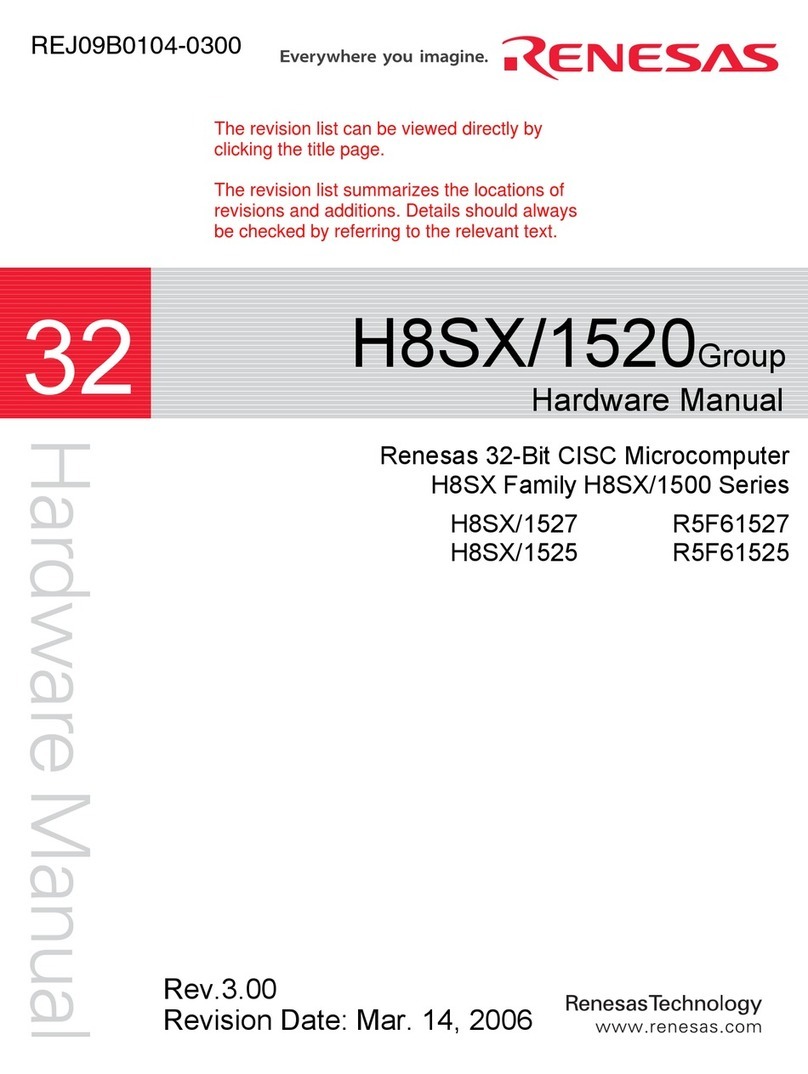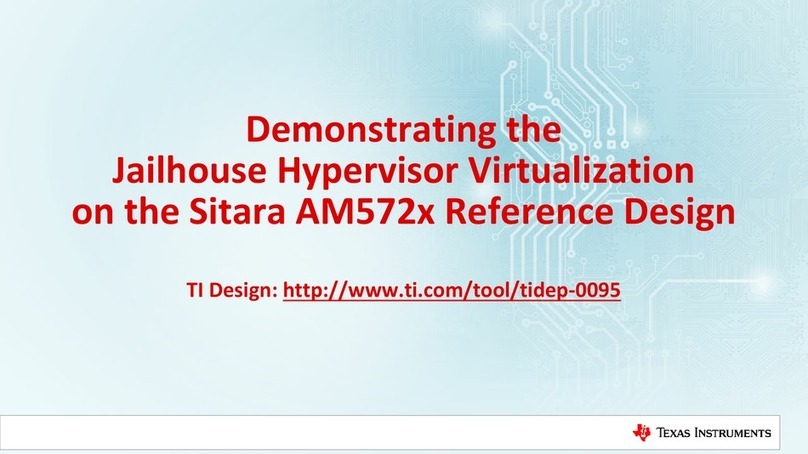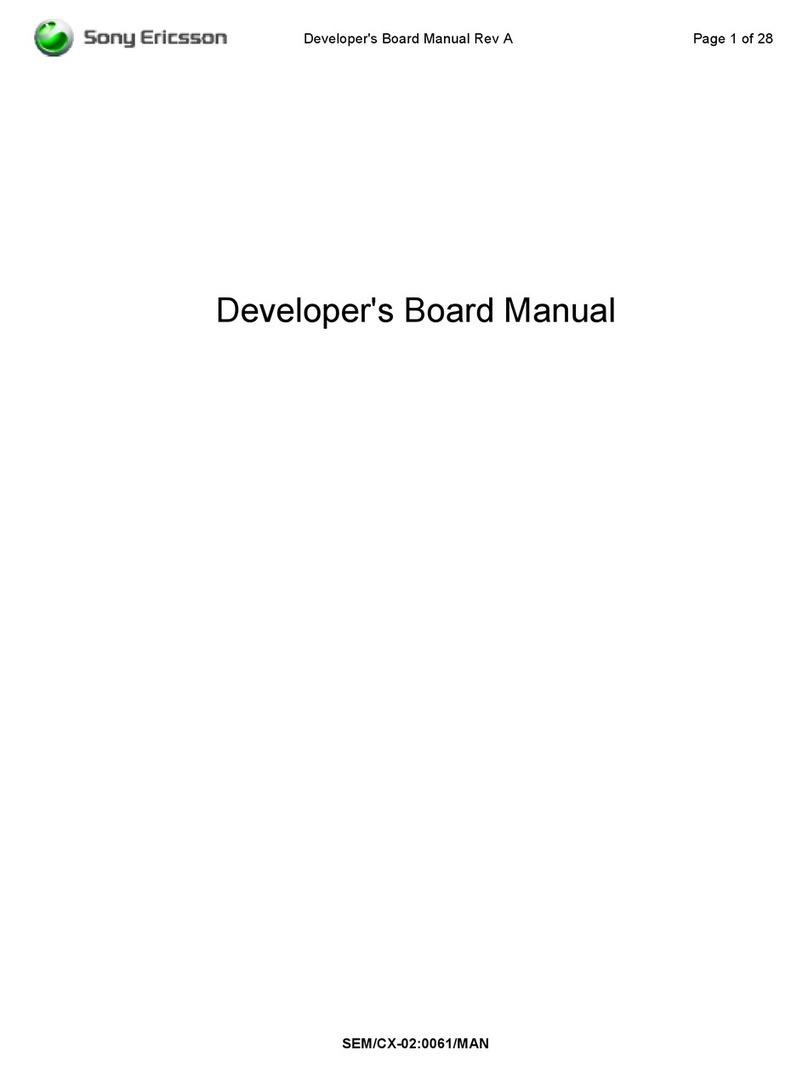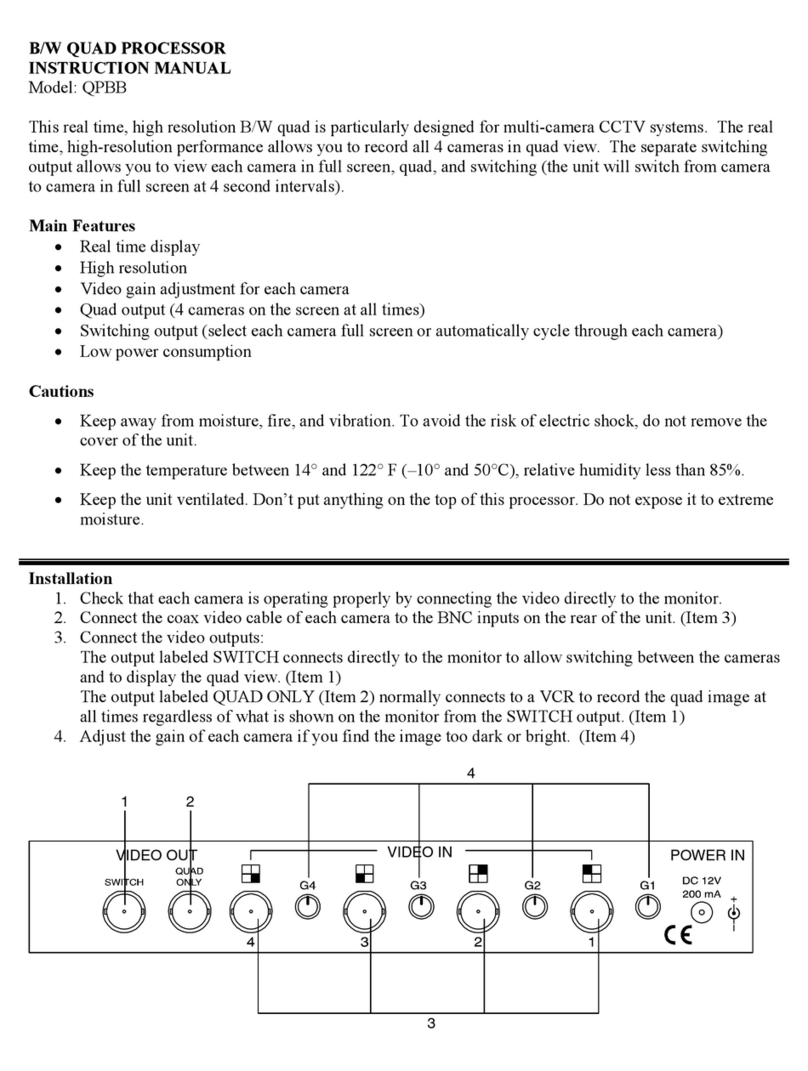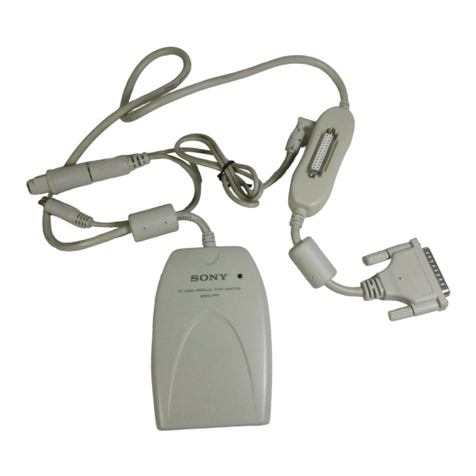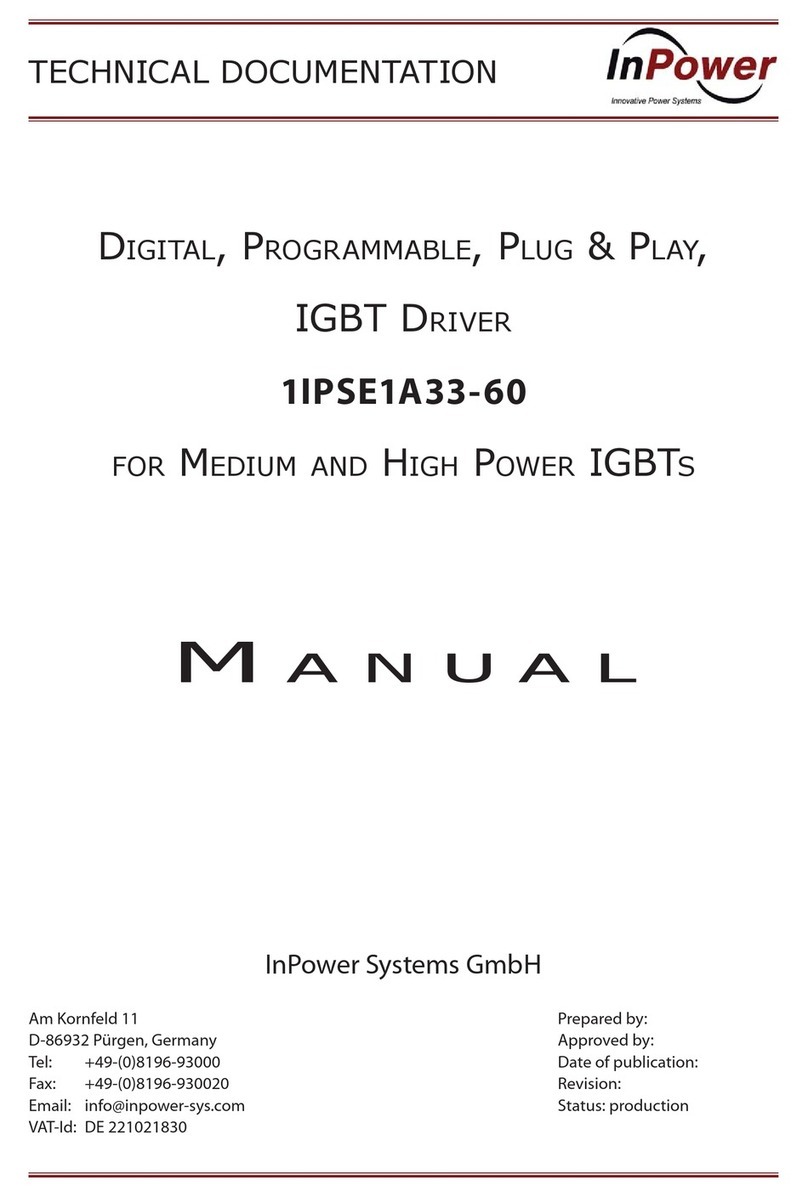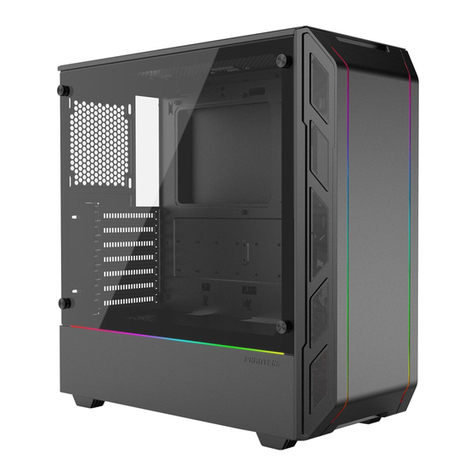METRObility Optical Systems R115-23 Operation manual

Installation & User Guide
Models: R115-23 / R115-24 / R115-25 / R115-26 / R115-27 /
R115-2J / R115-2X / R115-2Y / R175-23 / R175-24 / R175-25 /
R175-26 / R175-27 / R175-2J / R175-2X / R175-2Y
RADIANCE
T3/E3
SINGLE INTERFACE LINE CARDS
LK
PWR
LK
T3
LK
LK
T3
LK
LK
E3
LK
LK
E3
R
X
T
X
R
X
T
X
R
X
T
X
PWR PWR PWR
R
X
T
X
LBK
LBKLBK LBK LBK
LBK LBK LBK
SM MM MM SM
T
X
R
X
T
X
R
X
T
X
R
X
T
X
R
X
LK
PWR
LK
T3
LBK
LBK
BWDM
T
X
R
X
LK
PWR
LK
E3
LBK
LBK
BWDM
T
X
R
X

This publication is protected by the copyright laws of the United States and other countries, with all rights
reserved. No part of this publication may be reproduced, stored in a retrieval system, translated,
transcribed, or transmitted, in any form, or by any means manual, electric, electronic, electromagnetic,
mechanical, chemical, optical or otherwise, without prior explicit written permission of Metrobility Optical
Systems, Inc.
© 2002 Metrobility Optical Systems, Inc. All rights reserved. Printed in USA.
Radiance T3/E3 Single Interface Line Cards
T3 Copper to T3 Fiber:
R115-23 _____ T3 BNC to T3 multimode SC
R115-24 _____ T3 BNC to T3 singlemode SC
R115-25 _____ T3 BNC to T3 multimode ST
R115-26 _____ T3 BNC to T3 singlemode ST
R115-27 _____ T3 BNC to T3 singlemode SC (40km)
R115-2J______ T3 BNC to T3 singlemode SC (100km)
R115-2X _____ T3 BNC to T3 singlemode SC 1550/1310nm bidirectional wave-
length division multiplexed (BWDM)
R115-2Y _____ T3 BNC to T3 singlemode SC 1310/1550nm BWDM
E3 Copper to E3 Fiber:
R175-23 _____ E3 BNC to E3 multimode SC
R175-24 _____ E3 BNC to E3 singlemode SC
R175-25 _____ E3 BNC to E3 multimode ST
R175-26 _____ E3 BNC to E3 singlemode ST
R175-27 _____ E3 BNC to E3 singlemode SC (40km)
R175-2J _____ E3 BNC to E3 singlemode SC (100km)
R175-2X _____ E3 BNC to E3 singlemode SC 1550/1310nm BWDM
R175-2Y _____ E3 BNC to E3 singlemode SC 1310/1550nm BWDM

Table of Contents
Radiance T3/E3 Single Interface Line Cards Installation
& User Guide
Overview...............................................................................................................4
Installation Guide ................................................................................................5
STEP 1: Unpack the Line Card .....................................................................5
STEP 2: Set the Switches ..............................................................................5
STEP 3: Install the Line Card........................................................................6
STEP 4: Connect to the Network ..................................................................7
User Guide ...........................................................................................................9
LED Indicators ..............................................................................................9
Theory of Operation ....................................................................................10
Factory Settings...........................................................................................12
Link Loss Indications ..................................................................................14
Loopback Modes .........................................................................................16
Topology Solutions .....................................................................................18
Technical Specifications..............................................................................19
Acronyms and Abbreviations ......................................................................21
Product Safety, EMC and Compliance Statements .....................................22
Warranty and Servicing ...............................................................................23
Metrobility Optical Systems, the Metrobility Optical Systems logo, NetBeacon, and WebBeacon are
trademarks of Metrobility Optical Systems, Inc. All others are trademarks of their respective owners.
The information contained in this document is assumed to be correct and current. The manufacturer is
not responsible for errors or omissions and reserves the right to change specifications at any time
without notice.

4 Overview
Overview
Thank you for choosing the Radiance T3/E3 single interface line card.
The Metrobility Radiance T3/E3 line card provides high-speed integration and
conversion of T3 (44.736Mpbs) or E3 (34.368Mbps) coaxial telco communica-
tion lines to fiber transport environments. The copper data stream is converted to
optical signals for greater noise immunity and longer transmission. The T3/E3
line card supports remote fiber optic links up to 2km over multimode and up to
100km over singlemode cable.
To optimize your T3/E3 network, this hot-swappable media converter operates
seamlessly with low jitter. All signal activity is completely converted ensuring
accurate communication within connected segments. The Radiance T3 line card
features a user-selectable line build out, and all T3 and E3 models include
independent copper and fiber loopback modes to isolate problems within a
specific segment of the network.
Management options supported by the Radiance line cards include terminal
console commands, Metrobility’s GUI-based NetBeacon™or WebBeacon™
software, or any standard SNMP application. This ability provides remote
control over the line card’s configuration and immediate notification of a
problem to a management station.
The Radiance T3/E3 line card offers the following key features:
• B3ZS (T3) or HDB3 (E3) line code support on the coaxial interface.
• System and port LEDs on the front panel for easy diagnostics.
• Independent copper or fiber loopback mode that can be set with a DIP
switch or through software via local management.
• Individual port enable/disable.
• Line build out switch for short- or long-haul operation on the T3
models.
• Coaxial to multimode conversion up to 2km, coaxial to singlemode
conversion up to 100km, or coaxial to bidirectional wavelength
division multiplexed (BWDM) conversion up to 20km.
• Surge protection on the RX and TX ports of the coaxial interface.
• Low jitter for maximum transmission quality.
• Independent clocking on the RX and TX ports.
• Hot swappable.
• High MTBF.

Radiance T3/E3 Single Interface Line Cards 5
Installation Guide
Follow the simple steps outlined in this section to install and start using
your Radiance T3/E3 single interface line card.
NOTE: Electrostatic discharge precautions should be taken when handling any
line card. Proper grounding is recommended (i.e., wear a wrist strap).
Unpack the Line Card
Your order has been provided with the safest possible packaging, but
shipping damage does occasionally occur. Inspect your order carefully.
If you discover any shipping damage, notify your carrier and follow
their instructions for damage and claims. Save the original shipping
carton if return or storage of the unit is necessary.
Set the Switches
A bank of DIP switches is located on the back of the card. On the T3
cards, three functional switches are clearly labeled and allow you to
select from several modes of operation. On the E3 board, only the
switches labeled CLP and FLP are functional. Unmarked switches are
inoperative. Refer to the table below for the proper setting of the DIP
switches.*
When setting DIP switches, the UP position is when the lever of the
DIP switch is pushed away from the circuit board. The DOWN position
is when the lever is pushed toward the board.
LBO
CLP
FLP
1 65432
hctiwS lebaL noitisoPnoitcnuF
OBL
)ylno3T(
PU.)tf0021-552(tuOdliuBeniLluahgnoL
NWOD )tluafed( .)tf552-0(tuOdliuBeniLluahtrohS
PLC PU.tropreppocehtnodelbanesikcabpooL
NWOD )tluafed( .noitarepolamron;delbasidsikcabpoolreppoC
PLF PU.tropcitporebifehtnodelbanesikcabpooL
NWOD )tluafed( .noitarepolamron;delbasidsikcabpoolcitporebiF
1
2
*DIP switches also can be managed by console commands or via Metrobility’s NetBeacon or WebBeaconmanagement software.
Refer to the
Command Line Interface Reference Guide
,
NetBeacon Element Management Software Installation & User’s Guide
or
WebBeacon Management Software Installation & User’s Guide
for software management information.

6 Installation Guide
LBO Switch (functional only on T3 cards)
Set the Line Build Out (LBO) switch up to support a long haul connec-
tion if the length of your coaxial cable is between 255 and 1200 feet.
Set LBO down to support a short haul connection if the length of your
coaxial cable is between 0 and 255 feet. The default setting is short
haul.
CLP Switch
The Copper Loopback (CLP) switch enables/disables loopback on the
copper port. When copper loopback is enabled, the incoming data and
clock are looped from the RX copper port to the TX copper port, thus
returning the copper input back to the sending device. At the same time,
the data is transmitted to the remote T3/E3 line card. However, data
from the remote card is ignored. Loopback is disabled by default. For
more information, refer to “Loopback Modes” in the User Guide
section of this manual.
FLP Switch
The Fiber Loopback (FLP) switch enables/disables loopback on the
fiber optic port. When fiber loopback is enabled, the incoming data and
clock are looped from the RX fiber port to the TX fiber port. The data
is also transmitted to the copper port, however, data from the copper
port is ignored. Loopback is disabled by default. For more information,
refer to “Loopback Modes” in the User Guide section of this manual.
Install the Line Card
The Radiance T3/E3 line card offers the ease of plug-and-play installa-
tion and is hot-swappable. The card must be firmly secured to the
chassis before network connections are made. Follow the simple steps
outlined below to install the line card.
• Grasp the card by the front panel as shown.
3

Radiance T3/E3 Single Interface Line Cards 7
FX
PWR
RX
RX
LK
LK
M
M
FL
TX
TX
10/100
M
M
RX
LK
TX
FX
M
M
II
x
PWR
100 FD
RX
LK
T
X
TX
10/100
II
x
PWR
100 FD
RX
RX
LK
LK
T
X
M
M
FL
TX
TX
10/100
II
x
II
x
PWR
100 FD
100 FD
RX
RX
LK
LK
T
X
T
X
TX
TX
10/100
RX
LK
M
M
PWR
RX
LK
LBK
T1
MGT-10
LK
AT
C
O
N
S
O
L
E
T
P
PWR
A
B
R
ER
FX
PWR
RX
RX
LK
LK
M
M
FL
TX
TX
10/100
M
M
PWR
RX
RX
LK
LK
M
M
FL
TX
10/100
FX
M
M
PWR
M
M
OC-12
R
XLK
LK
T
X
S
M
R
X
T
X
LX
LK
LK
PWR
1000BASE
S
M
SX
M
M
100 BASE
RX
RX
T
X
Card Guide
Card Guide Slot for Management Card
Thumb Screw
Blank Panel
IMPORTANT!
Tighten thumb screw
to secure each card firmly
to chassis before making
network connections.
FX
PWR
RX
RX
LK
LK
M
M
FL
TX
TX
10/100
M
M
FX
PWR
RX
RX
LK
LK
M
M
FL
TX
TX
10/100
M
M
PWR
M
M
OC-12
R
XLK
LK
T
X
S
M
R
X
T
X
PWR
M
M
OC-12
R
XLK
LK
T
X
S
M
R
X
T
X
PWR
M
M
OC-12
R
XLK
LK
T
X
S
M
R
X
T
X
PWR
M
M
OC-12
R
XLK
LK
T
X
S
M
R
X
T
X
R
X
T
X
E3
LK
LK
LBK
LBK
LBK
MAN FD PWR
LK
LBK
L
H
FX
LK
LBK
II
x
DIS
DIS
R
X
T
X
R
X
T
X
SM
MAN
TX
FX
T
X
R
X
• Insert the card into a slot in the chassis making sure that the top and
bottom edges of the board are aligned with the top and bottom card
guides in the chassis. Do not force the card into the chassis unneces-
sarily. It should slide in easily and evenly.
• Slide the line card in until the top and bottom edges of the front
panel are flush and even with the top and bottom edges of the
chassis.
• To secure the line card to the chassis, turn the thumbscrew clockwise
until it is snug. The card is now properly installed and ready for
connection to the network.
Connect to the Network
To connect the line card to the network, insert the cables into the
appropriate connectors as shown in the following illustration. Make
sure the card is secured to the chassis before making network connec-
tions. Once power is applied to the unit, correct connectivity can be
verified via the link (LK) LED.
When making network connections, make sure that the receive (RX)
port of the card connects to the transmit (TX) port of the connected
device, and make sure that the receive port of the connected device
connects to the transmit port of the line
card.
4

8 Installation Guide
Coaxial Interface
The coaxial interface provides two BNC connectors. The transmit (TX)
port is located above the receive (RX) port. Each connector supports a
maximum segment length of 1200 feet. Use only RG-59 cables.
Fiber Optic Interface
The line card’s fiber optic receive (RX) port is located above its
transmit (TX) port.
The fiber optic multimode (MM) interface supports a maximum
segment length of 2km for remote links.
The standard singlemode (SM) connector supports a maximum
segment length of 15km.
On the R115-27 and R175-27, the singlemode long haul interface
supports a maximum segment of 40km.
On the R115-2J and R175-2J, the singlemode extended long haul
interface supports a maximum segment length of 100km.
BWDM Connection
The bidirectional wavelength division multiplexed (BWDM) port
provides one singlemode SC connector that supports a maximum
segment length of 20km. BWDM line cards must always be used in
complementary pairs. That is, a -2X model must always be connected
to a -2Y. The -2X cards are designed to transmit data at a wavelength of
1550nm and receive at 1310nm. Correspondingly, the -2Y cards
transmit data at 1310nm and receive at 1550nm.
AT
PWR
LK
T3
RX
LK
TX
FX
M
M
II
x
PWR
100 FD
RX
LK
TX
10/100
RX
LK
TX
FX
M
M
II
x
PWR
100 FD
RX
LK
T
X
TX
10/100
AT
RX
E3
II
x
PWR
100 FD
RX
RX
LK
LK
T
X
M
M
FL
TX
TX
10/100
II
x
II
x
PWR
100 FD
100 FD
RX
RX
LK
LK
T
X
T
X
TX
TX
10/100
S
M
E1
M
M
T1
RX
LBK
RX
T1 MGT-10
LK
AT
C
O
N
S
O
L
E
T
P
PWR
A
B
R
ER
FX
PWR
RX
RX
LK
LK
M
M
FL
TX
TX
10/100
M
M
PWR
T3
RX
LK
TX
FX
M
M
II
x
PWR
100 FD
RX
LK
T
X
TX
10/100
RX
LK
TX
FX
M
M
II
x
PWR
100 FD
RX
LK
T
X
TX
10/100 PWR
R
X
LK
LK
M
M
T
X
100 BASE PWR
RX
RX
LK
LK
M
M
FL
TX
TX
10/100
FX
M
M
RX
LK
TX
FX
M
M
II
x
PWR
100 FD
RX
LK
T
X
TX
10/100
R
X
M
M
T
X
AT
AT
PWR
LBK
LBK
PWR
PWR
LBK
PWR
ALM
ALM
R
X
T
X
R
X
T
X
R
X
T
X
R
X
T
X
R
X
T
X
S
M
RX
LBK
ALM
RX
LBK
ALM
RX
LBK
ALM
RX
LBK
ALM
LK
LK
LBK
LBK
MAN
TX
FX
MM
TX
FX
TX
FX
MAN MAN
SM
LK
T
X
R
X
T
X
R
X
T
X
R
X
BWDM

Radiance T3/E3 Single Interface Line Cards 9
User Guide
This section contains more detailed information regarding the operating
features of the Radiance T3/E3 single interface line card.
LED Indicators
The Radiance T3/E3 single interface line card provides several LEDs for the
visible verification of unit status and proper functionality. These LEDs can aid in
troubleshooting and overall network diagnosis and management.
DELmetsyS
DEL lebaL /roloC sutatS noitacidnI
RWP neerG.rewopgniviecersitinU
FFO.deliafsahrorewopgniviecertonsitinU
sDELtroPreppoC
DEL lebaL /roloC sutatS noitacidnI
KL neerG.tropeviecerreppocehtnotneserpsilangisA
FFO.tropehttadetcetedsilangisoN
KBL wolleY ehtnosemarfgnimocnI.edomkcabpoolnisitropreppoC siataD.eniltimsnartlaixaocehtnokcabtneseratropreppoc .eniltimsnartcitporebifehthguorhttnesosla
FFO.noitarepolamron;tropreppocehtnodelbasidsikcabpooL
sDELtroPcitpOrebiF
DEL lebaL /roloC sutatS noitacidnI
KL neerG.tropeviecercitporebifehtnotneserpsilangislacitponA
FFO.troprebifehttadetcetedsilangisoN
KBL wolleY erakcolcdnaatadgnimocnI.edomkcabpoolnisitroprebiF tuodettimsnartoslasiataD.enilrebiftimsnartehtnokcabtnes .eniltimsnartlaixaoceht
FFO.noitarepolamron;troprebifehtnodelbasidsikcabpooL

10 Installation Guide
Theory of Operation
Data Transparency
The Radiance T3/E3 single interface line card offers full data transparency. Any
codes or commands contained within the data stream are passed through to the
remote device. The only commands executed by the T3/E3 card are those set
through the hardware (i.e., DIP switches) or software, which communicates with
the card via the management bus on the chassis backplane.
Functional Block Diagram
Line
Transformers
Line
Interface
Unit FPGA
VCXO
Fiber
Optic
Circuit
RX
Coaxial
TX
TX
Fiber
RX
Coaxial to Fiber Data Path
The receive (RX) port on the coaxial interface accepts an electrical signal. This
signal is coupled to the line interface unit (LIU) through a line transformer. The
LIU performs clock and data recovery and converts the signal into non-return to
zero (NRZ) data and clock. The NRZ data and clock then pass through the field-
programmable gate array (FPGA), which encodes the data for fiber optic
transmission. The encoding ensures adequate transition density for reliable clock
recovery at the remote T3/E3 fiber optic interface.
Fiber to Coaxial Data Path
The RX port on the fiber interface accepts an optical signal from the remote T3/
E3 line card and converts it back to an electrical signal. The optical signal first
enters the voltage-controlled crystal oscillator (VCXO), which extracts the line
rate clock and data. The recovered clock and data are then sent to the FPGAfor
decoding. The decoded data stream goes to the LIU for encoding into T3 or E3
signals. The transmitted signal is coupled to the BNC coaxial connector through
a line transformer.
On both the RX and TX ports of the coaxial interface, surge protection is
provided.

Radiance T3/E3 Single Interface Line Cards 11
Timing Paths
The transmit (TX) and receive (RX) paths are clocked independently and during
normal operation, the Radiance T3/E3 line cards are never timing masters of the
network system. In the coaxial to fiber path, timing is recovered by the card’s
LIU and transmitted over the fiber line to the remote T3/E3 line card. In the
fiber to coaxial path, timing is derived from the incoming optical signal and sent
over the coaxial TX line.
Local
T3/E3
Line Card
Remote
T3/E3
Line Card
Coaxial CoaxialFiber
A
F
C
B
ED
The following table describes how timing is affected if a failure occurs at
various points in the network.
eruliaFeniL tnioP tluseR
As'reviecerrebifehT.langisfossolstceteddracenil3E/3TlacolehT .BknilrebifrevonoissimsnartrofecruosgnimitehtsemocebOXCV
BkcolcecnereferstiotstreverOXCVs'dracenil3E/3TetomerehT .retsamgnimitmetsysehtsemocebdrac3E/3TetomerehT.tupni
C
stroppusdracenil3E/3TetomerehtotdetcennoctnempiuqeehtfI kcolclanretnistiottreverdluohstnempiuqeeht,gnimitdepool liafdluoctnempiuqeeht,ylevitanretlA.langisfossolstcetedtinehw fisaevaheblliwmetsysehtdna,kcolcrolangisdilavaedivorpot .Dtnioptaderruccoeruliafeht
DrebifehT.langisfossolstcetedUILs'drac3E/3TetomerehT revonoissimsnartrofecruosgnimitehtsemocebOXCVs'reviecer .Eknilrebif
EkcolcecnereferstiotstreverOXCVs'dracenil3E/3TlacolehT .retsamgnimitmetsysehtsemocebdrac3E/3TlacolehT.tupni
FehtotdetcennocecivedehT.srucconoitpursidgnimitmetsysoN .langisfossolstceteddrac3E/3Tlacol

12 Installation Guide
Factory Settings
Default Hardware Settings
Copper Loopback .................................................................................... Disabled
Fiber Loopback........................................................................................ Disabled
Line Build Out (T3 models only) ......................................... Short Line (0-255 ft)
The hardware DIP switches can be overridden through software. Resetting the
line card via software will force the settings back to their default states and
return control to the hardware.
Default Software Setting
Port Enable/Disable ...................................................................................Enabled
Port Enable/Disable
Through software, either port on the T3/E3 line card can be enabled or disabled
independently. Disabling a port stops the flow of data to and from that port. If
the copper port is disabled, no signals will be sent from the coaxial transmitter
and an unframed all-ones pattern will be transmitted over the fiber line to the
remote line card.
Note: An all-ones pattern indicates an alarm indication signal (AIS) for the E3
line cards only. For T3 cards, the all-ones pattern is simply transmitted to the
remote device; it does NOT indicate AIS.
Remote
Device
Receives All 1s
Local Device
Detects
No Link
Local T3/E3
Card with Copper
Port Disabled
Remote T3/E3
Fiber Port
Receives All 1s
unlit LED
Coax CoaxFiber
green LED
LK
LK
LK
LK
All Ones All Ones
If the fiber port is disabled, no signals will be sent from the fiber transmitter, and
an unframed all-ones pattern will be passed from the copper port.

Radiance T3/E3 Single Interface Line Cards 13
Remote
Device
Receives All 1s
Local Device
Receives
All 1s
Local T3/E3
Card with Fiber
Port Disabled
Remote T3/E3
Fiber Port Detects
No Link
unlit LED
Coax
Coax
Fiber
green LED
LK
LK
LK
LK
All Ones
All Ones
Once a port is disabled, the only way to enable it again is through software.
Through SNMP management, NetBeacon or WebBeacon*, you can view the
following information for the Radiance T3/E3 line card.
• Fiber and copper signal status
• Port operational status
• Port loopback mode
• Board serial identification
• FPGA firmware revision
* Refer to the
Command Line Interface Reference Guide
,
NetBeacon Element Management Software Installation & User’s Guide
or
WebBeacon Management Software Installation & User’s Guide
for software management information.

14 User Guide
Link Loss Indications
The following examples show the status of the LK LED under various link
conditions and describe when unframed all ones (AIS for E3 only) are gener-
ated. (Loopback is disabled in these examples.)
Normal
The diagram below shows a typical configuration with good link status.
Remote
Device
Local
Device Local T3/E3
Line Card Remote T3/E3
Line Card
green LED unlit LED
Coax CoaxFiber
LK
LK
LK
LK
Input Coaxial Link Loss
Loss of the copper input disables the BNC port’s LK LED. It also forces the T3/
E3 card to generate unframed all ones (AIS for E3 only), which are transmitted
out its fiber port. For example, if the local card’s inbound coaxial cable breaks, it
will transmit all ones to the remote T3/E3 card via the fiber cable. The remote
card then carries the pattern forward via its coaxial cable to the remote device.
Remote
Device
Local
Device Local T3/E3
Line Card Remote T3/E3
Line Card
green LED unlit LED
Coax CoaxFiber
LK
LK
LK
LK
All Ones All Ones
All Ones carried forward
Input Fiber Link Loss
Loss of the fiber input is indicated by the fiber port’s unlit LK LED. When the
fiber input is lost, an all-ones pattern is transmitted from the coaxial port, as
shown in the illustration below.
Remote
Device
Local
Device Local T3/E3
Line Card Remote T3/E3
Line Card
green LED unlit LED
Coax CoaxFiber
LK
LK
LK
LK
All Ones

Radiance T3/E3 Single Interface Line Cards 15
Remote Output Coaxial Link Loss
Loss of link to the remote device produces a red alarm condition at the remote
site and should force the device to revert to its internal clock. If the remote
device is configured to send back a yellow alarm (AIS) under this condition, the
two Radiance T3/E3 line cards will carry the alarm forward to the local device,
as shown below.
Remote
Device
Local
Device Local T3/E3
Line Card Remote T3/E3
Line Card
green LED unlit LED
Coax CoaxFiber
LK
LK
LK
LK
AIS AIS
AIS carried forward
AIS

16 User Guide
Loopback Modes
The Radiance T3/E3 line card features two loopback modes to help verify
correct installation and to diagnose system problems.
Normal
During normal operation, without loopback, data from a local device (CSU,
PBX, etc.) enters the local T3/E3 line card’s coaxial receiver, passes through the
fiber line between the two cards, then exits the remote card’s coaxial transmitter
to enter the remote equipment, and vice versa.
Local T3/E3
Line Card Remote T3/E3
Line Card
Coax Coax
Fiber
Local
Device Remote
Device
Loopback
Loopback helps to isolate and identify traffic problems within a specific
segment. During loopback, the yellow LBK LED is lit. Loopback can be
enabled/disabled in two ways: (1) by setting a DIP switch, or (2) through
software by enabling loopback on Port 1 (copper) or Port 2 (fiber). Once
loopback is enabled, the card will remain in this mode until either the DIP
switch is reset or the software setting is changed.
Copper and fiber loopback cannot be enabled at the same time. If both DIP
switches are enabled, only the first one set will be in effect until it is disabled.
Copper Loopback
During copper loopback, timing and data received on the coaxial line are
looped back to the sending device. The loop occurs in the FPGA. The data
is also transmitted to the remote card, but the data from the remote unit is
ignored by the card in loopback mode.
In the example shown below, the local T3/E3 line card has copper loopback
enabled. Data received at the BNC port is simultaneously returned to the
local device and sent to the remote T3/E3 card and on to the remote device.
Data from the remote device is transmitted by the remote card, however, it
is ignored by the local card at its fiber optic interface.

Radiance T3/E3 Single Interface Line Cards 17
Local T3/E3 Card
with Copper Loopback Remote T3/E3
Card
Coax Coax
Fiber
Local
Device Remote
Device
X
Fiber Loopback
In this mode, the incoming data and clock on the fiber line are looped back.
The loop occurs in the FPGA. The data is still sent out the coaxial transmit-
ter. However, the data received at the BNC interface is ignored.
In the diagram below, the remote T3/E3 line card has fiber loopback
enabled. Data received at the fiber optic port is simultaneously returned to
the local device and sent to the remote device. However, data from the
remote device is ignored by the remote T3/E3 line card at its coaxial
interface.
Local T3/E3
Card Remote T3/E3 Card
with Fiber Loopback
Coax Coax
Fiber
Local
Device Remote
Device
X
Loopback with Port Disabled
If loopback is enabled on a port that has been disabled, the loop will still
occur and the loopback LED will be lit. However, only an unframed all-
ones pattern (AIS for E3) will be sent from the opposite transmitter. No
signal will be sent from the disabled transmit port, as shown in the example
below.
Local T3/E3 Card
with Copper Loopback
and Copper Disable Remote T3/E3
Card
Coax Coax
Fiber
Local Device
Detects
No Signal Remote
Device
X
All Ones All Ones
X

18 User Guide
Topology Solutions
The Radiance T3/E3 single interface line card is a point-to-point media
converter designed to extend the reach of copper T3/E3 links and to provide
protection from power surges and electromagnetic interference. Each T3/E3 line
card supports a single remote T3/E3 card.
fiber T3/E3
Radiance R5000 with
T3/E3 Line Cards
copper T3/E3
Radiance
R5000 with
T3/E3 Line Cards
up to 2km
multimode
Radiance
R5000 with
T3/E3 Line Cards
up to 100km
singlemode
up to 100km
singlemode
Private Branch Exchange (PBX) PBX
PBX
CSU
Metrobility
T3/E3 Standalone
Radiance R5000 withT3/E3 Line Cards
Radiance
R5000 with
T3/E3 Line Cards
up to 100km
singlemode
Data Service Unit (DSU)
Channel Service Unit (CSU)

Radiance T3/E3 Single Interface Line Cards 19
Technical Specifications
Network Connections
Coaxial Interface
Connector __________________________________________ BNC receptacle
Impedance________________________________________________ 75 ohms
Signal Structure ____________________________ ANSI T1.404, T1404a (T3)
_____________________________________ ITU G.703 (E3)
Supported Link Length___________________________________ up to 1200 ft
Cable Type ______________________________________ RG-59 coaxial cable
Multimode Fiber Optic Interface
Connector ________________________________________________ST or SC
Wavelength _______________________________________________ 1310 nm
RX Input Sensitivity ___________________________ -31 dBm peak minimum
Output Power _______________________ -20 dBm to -14 dBm (62.5/125 µm)
Supported Link Length____________________________ up to 2km full duplex
Cable Type __________________________________ 50/125, 62.5/125 µm F/O
Singlemode Fiber Optic Interface
Connector ________________________________________________ST or SC
Wavelength _______________________________________________ 1310 nm
RX Input Sensitivity ___________________________ -31 dBm peak minimum
Output Power ___________________________ -15 dBm to -8 dBm (9/125 µm)
Supported Link Length___________________________ up to 15km full duplex
Cable Type ______________________ 8.3/125, 8.7/125, 9/125, 10/125 µm F/O
Singlemode Fiber Optic Interface — long haul distance support
Connector _____________________________________________________SC
Wavelength _______________________________________________ 1310 nm
RX Input Sensitivity ________________________________ -35 dBm minimum
Output Power _____________________________-5 dBm to 0 dBm (9/125 µm)
Supported Link Length___________________________ up to 40km full duplex
Cable Type ______________________ 8.3/125, 8.7/125, 9/125, 10/125 µm F/O

20 User Guide
Singlemode Fiber Optic Interface — extended long haul distance support
Connector _____________________________________________________SC
Wavelength _______________________________________________ 1550 nm
RX Input Sensitivity ________________________________ -37 dBm minimum
Output Power ___________________________ -3.0 dBm to 0 dBm (9/125 µm)
Supported Link Length__________________________ up to 100km full duplex
Cable Type ______________________ 8.3/125, 8.7/125, 9/125, 10/125 µm F/O
Singlemode BWDM Fiber Optic Interface
Connector _____________________________________________________SC
Supported Link Length___________________________ up to 20km full duplex
Cable Type ___________________________________________ 9/125 µm F/O
(R115-2X, R175-2X)
TX Wavelength ___________________________________________1550nm
RX Wavelength ___________________________________________1310nm
RX Input Sensitivity ______________________________ -32 dBm minimum
Output Power _________________________ -8 dBm to -15 dBm (9/125 µm)
(R115-2Y, R175-2Y)
TX Wavelength ___________________________________________1310nm
RX Wavelength ___________________________________________1550nm
RX Input Sensitivity ______________________________ -32 dBm minimum
Output Power _________________________ -8 dBm to -15 dBm (9/125 µm)
Data Rate
Data Rate __________________________ 44.736Mbps (T3); 34.368Mbps (E3)
Power
Input __________________________________ +5.0VDC @ 0.4A, 2W average
Environmental
Operating Temperature ____________________________________ 0°to 55°C
Storage Temperature____________________________________ -30°to 70°C
Relative Humidity __________________________ 5% to 95% non-condensing
Weight_______________________________________________ 5 oz (0.14 kg)
This manual suits for next models
15
Table of contents
Other METRObility Optical Systems Computer Hardware manuals
